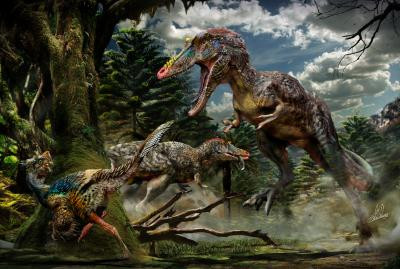Pinocchio Rex: 66-Million-Year-Old Species of T-Rex Cousin Discovered in China

The remains of a long-nosed dinosaur, believed to be a cousin of Tyrannosaurus rex, have been discovered in southern China.
Nicknamed Pinocchio rex, Qianzhousaurus sinensis is believed to have stalked the Earth over 66 million years ago, during the late Cretaceous period. Researchers said the creature was a fearsome carnivore which lived in Asia.
The newly found ancient predator, described by paleontologists from the Chinese Academy of Geological Sciences and the University of Edinburgh, looked very different from most other tyrannosaurs. It had an elongated skull and long, narrow teeth compared with the deeper, more powerful jaws and thick teeth of a conventional T. rex.
At about 29ft long and weighing 800 kilograms, the dinosaur was smaller and likely sprightlier than the 42ft long T. rex, as reported by National Geographic.

The remains are of an animal nearing adulthood, which were found largely intact and remarkably well preserved. The dinosaur was found by workmen on a construction site near Guangzhou, southern China over 12 months ago.
Until now, only two fossilised tyrannosaurs with elongated heads had been found, both of which were juveniles. It was unclear whether these were a new class of dinosaur or if they were at an early growth stage, and might have gone on to develop deeper, more robust skulls.
Experts say Qianzhousaurus sinensis lived alongside deep-snouted tyrannosaurs but would not have been in direct competition with them, as they were larger and probably hunted different prey.
Pinocchio rex lived until around 66 million years ago, when all of the dinosaurs became extinct, likely as the result of a deadly asteroid impact.
Dr Steve Brusatte, of the University of Edinburgh's School of GeoSciences, and one of the authors of the study, said: "This is a different breed of tyrannosaur. It has the familiar toothy grin of T. rex, but its snout was much longer and it had a row of horns on its nose. It might have looked a little comical, but it would have been as deadly as any other tyrannosaur, and maybe even a little faster and stealthier."
He added that Pinocchio's snout was 35% longer than animals of its size, but the reasons for this are unknown.
"The truth is we don't know yet. But it must've been doing something different," Dr Brusatte told BBC News. "The iconic picture of a tyrannosaur is T. Rex, the biggest, baddest dinosaur of all. But this new dinosaur had a lighter skeleton. Perhaps it had a faster bite and hunted in a different way. It breaks the mould for what we think of as a tyrannosaur."
Professor Junchang Lü, of the Institute of Geology, Chinese Academy of Geological Sciences, said: "The new discovery is very important. Along with Alioramus from Mongolia, it shows that the long-snouted tyrannosaurids were widely distributed in Asia. Although we are only starting to learn about them, the long-snouted tyrannosaurs were apparently one of the main groups of predatory dinosaurs in Asia."
In recent years, two skeletons with unusually prominent proboscises were unearthed in Mongolia.
The findings were published in the journal Nature Communications.
© Copyright IBTimes 2025. All rights reserved.






















